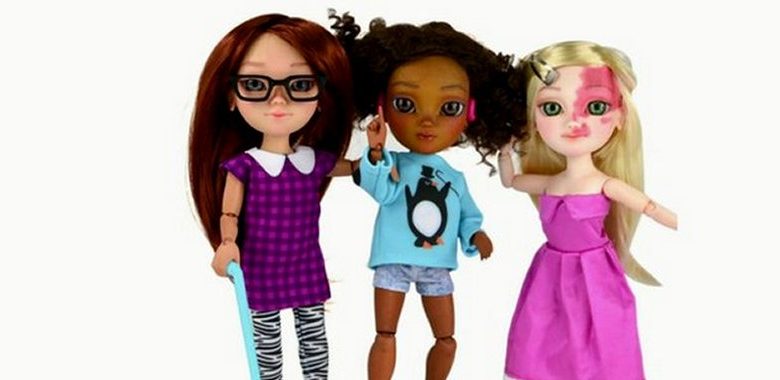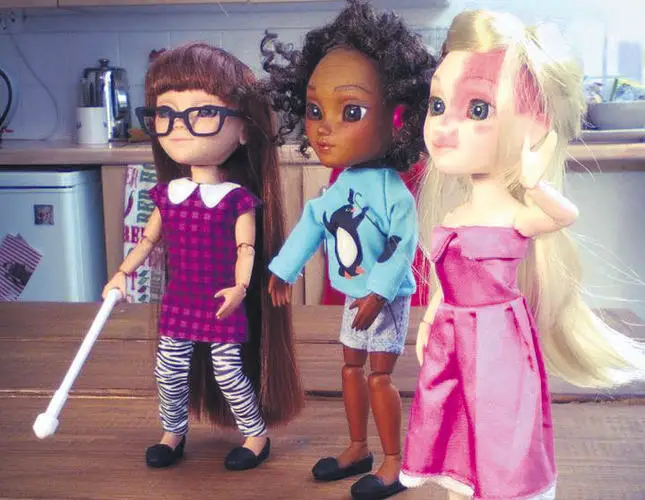
Toys Like Me dolls: a good or bad idea?
This is an updated post from our archives. The article discusses the introduction of ‘Toys Like Me’ dolls, which are designed to represent disabled children, and explores whether this initiative promotes inclusivity or inadvertently leads to further segregation.
Recent Developments in Inclusive Toys
Since the inception of the ‘Toys Like Me’ campaign, there has been a significant increase in the availability of inclusive toys that represent disabled children. Notably:
- Barbie’s Inclusive Range: In July 2024, Barbie introduced its first blind doll, complete with a white and red cane, sunglasses, and tactile clothing. This initiative, developed in collaboration with the Royal National Institute of Blind People (RNIB), aims to provide representation for visually impaired children. Read more.
- Lottie Dolls: The Lottie Dolls range includes dolls with cochlear implants, autism, and achondroplasia, promoting diversity and inclusion in children’s toys. Learn more.
- Etsy Artisans: Various artisans on platforms like Etsy offer handmade dolls with disabilities, including limb differences, hearing aids, and medical devices, catering to a diverse range of needs and preferences. Explore options.
These developments reflect a growing recognition of the importance of representation in toys, helping children with disabilities see themselves reflected in their playthings and fostering empathy and understanding among all children.
Original post follows:
“Raggy Dolls, Raggy Dolls, dolls like you and me…” the theme to one of my old childhood’s favourite cartoons – ‘Raggy Dolls’ sprang into my head as I heard about ‘Toys Like Me’. Raggy Dolls was a children’s cartoon where the dolls that did not meet the factory’s standards got sent into a recycle section. I remember watching it and thinking; “is that why I am in a special needs school, because I failed to meet the world’s standard of perfection?”
Although I loved my school, I couldn’t help but feel segregated from the rest of society. This was a feeling that used to reach its peak when people would stare at us on the school bus, making us feel like exhibits or creatures from out of space.
Because of my experiences as a child, I have been writing endlessly about the need for children to be exposed to disability from an early age, as it would teach and encourage them to be accepting of people living with disability.
In the past I have argued for more diversity in literature as I was shocked by the void of disability in adult and children’s books alike, and I’ve written endlessly about the need for TV, film and animation makers to include characters with disability in their productions. Like it or not, social and general media are the ‘educators’ of our time – it holds the power that influence public perception and opinion.
I was therefore really pleased to see the ‘Toys Like Me’ campaign turn into reality with London based toymakers Makies having begun making toys with disability.
However, although part of me was pleased at the new line of toys, I could not help but feel it is a step backwards, a form of segregation almost. Our society has become so focused on political correctness and ‘seeming’ to be inclusive that in actual fact we are digressing into a form of seclusion and breaking into small communities according to ability, faith, ethnicity, sexual orientation etc.
Just as there are now disabled dolls/toys, I recently came across a Muslim doll that had a veil but was faceless in accordance with some strict Muslim guidelines. While it is a positive thing for children to see similarity in their surrounding, why isolate and expose them to the idea of ‘different’. There should be a mixed balance where toys/dolls are reflective of our world, but in a manner that is truly inclusive, not where the dolls are not just ‘like me’ but ‘you and me’.
A while back there was a big frenzy about the new age Barbie; one that had a scar, another with a tattoo, one that was overweight, and even a disabled one. At the time I wondered why there was an obsession with changing a traditional figure like Barbie to something else? I was a child that loved dolls, Barbies and tea sets. I was very girly back then and I thoroughly enjoyed playing for hours with all these non-disabled toys without ever wondering why are they not like me?
Nor did it affect me, I just accepted them as dolls that don’t need to be like anyone. Although sometimes I did invent my own version of a wheelchair for my doll and added little ‘imaginary’ features that contributed to making that particular doll disabled, but that was to fit a role play that I had created, rather than an urge to recreate an image of myself.
Also if we look at the dolls that have been made a question forces itself; how disabled are these dolls? Just because one uses a crutch or hearing aid and another has birth mark/scar, they still don’t represent all the disabilities because there is more to disability than just equipment aids. Therefore there will still be many left thinking; “even among disabled dolls there is no space for me.”
This is precisely my problem with these dolls; in theory they are an introduction to a more inclusive world but, in reality, they are cementing segregation and a notion I strongly believe in – our world is tolerant but not accepting. I am not against the idea of these dolls, on the contrary, I welcome any attempts that are made to promotes inclusion and equality, but I want that to be in a progressive and balanced manner.
Therefore I personally feel that books, films and TV, all facets of the media so prominent in all our lives, is where inclusion should occur and not necessarily through manufacturing dolls that are disabled.
By Raya AlJadir
Originally posted on 27/07/2015 @ 12:30 am

Interesting article. When I first heard about Lego finally agreeing to produce a disabled mini-figure, I never thought of it as satisfying a child’s “urge to recreate an image of [themselves]”. I think the purpose of disabled toy characters should be to normalise disability by exposing non-disabled children to the representations various disabilities. I’m surprised that the Toys like Us campaign talks more about the self-image of disabled children, rather than the perceptions of non-disabled children.
When I was a kid my life basically revolved around Lego. Being disabled, like yourself, I don’t recall “ever wondering why are they not like me?”. However, if you think in terms of changing the perceptions or non-disabled children, then disabled dolls begin to have a much more clear purpose.
I certainly agree with your statement that “books, films and TV, all facets of the media so prominent in all our lives, is where inclusion should occur”. I would however add that media tie-ins–Star Wars, Harry Potter, toys, Lego, boardgames, etc– and by extension toys to represent disabilities in general are still of great value.